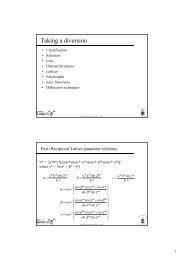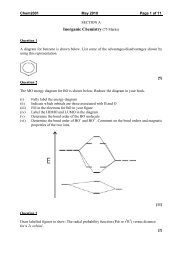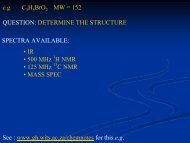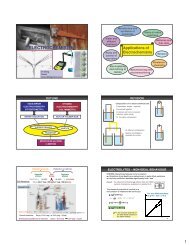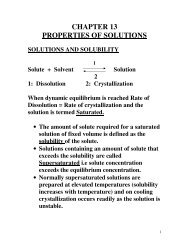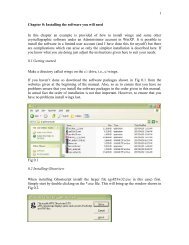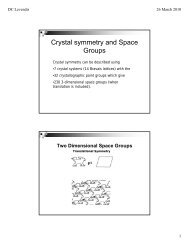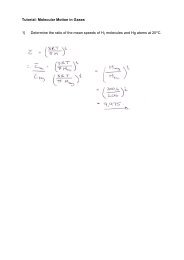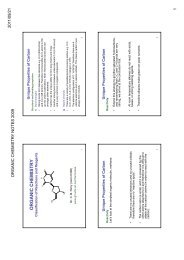ELECTROCHEMISTRY - Wits Structural Chemistry
ELECTROCHEMISTRY - Wits Structural Chemistry
ELECTROCHEMISTRY - Wits Structural Chemistry
You also want an ePaper? Increase the reach of your titles
YUMPU automatically turns print PDFs into web optimized ePapers that Google loves.
Fick’s second law of diffusion or the<br />
diffusion equation:<br />
2<br />
∂c<br />
∂ c<br />
= D<br />
2<br />
∂t<br />
∂x<br />
→ describes time<br />
dependence of the<br />
diffusion process<br />
Diffusion coefficients at 298 K, 10 -9 m 2 s -1 Example 9<br />
H + in water<br />
9.31<br />
The mobility of the NO 3- ion in aqueous solution at 25 °C is 7.40×10 -8 m 2 s -1 V -1 .<br />
Na + in water<br />
1.33<br />
(Viscosity of water is 0.89110 -3 kg m -1 s -1 ).<br />
sucrose in water 0.522<br />
Calculate its diffusion coefficient and the effective radius at this temperature.<br />
It shows that the rate of change of conc is proportional to the<br />
curvature (the second derivative) of the concentration with<br />
respect to the distance.<br />
This equation shows that:<br />
1) If the concentration changes sharply from point to<br />
point, then the concentration changes rapidly in time.<br />
c<br />
vs<br />
c<br />
x<br />
x<br />
2) If the curvature = 0, then the concentration does not<br />
change in time.<br />
3) If the concentration decreases linearly with distance,<br />
then the concentration is constant at any point,<br />
because the inflow is exactly balanced by the outflow<br />
of particles or ions.<br />
c<br />
x<br />
Remember: in the calculations you have to show the work on units.<br />
Without that, the work might be considered as not done at all.<br />
DYNAMIC <strong>ELECTROCHEMISTRY</strong><br />
Double Layer at the Electrode-Solution Interface<br />
Dynamic Equilibrium<br />
Butler-Volmer Equation<br />
No Mass Transport Effects<br />
Mass Transport Effects<br />
Tafel Plot<br />
Electrolysis and Galvanic Cells<br />
Double Layer at the Electrode-Solution Interface<br />
Electrode reaction = heterogeneous chemical process<br />
e - ’s move from electrode surface to chemical species in solution (at the surface), or<br />
vice versa<br />
Diffusion layer – region<br />
dominated by unequal<br />
(1 µm − 1 mm) charge distribution<br />
Region of charge neutrality<br />
Part of Chapter 22<br />
(1 − 10 nm)<br />
Double layer generated due<br />
to electrostatic forces<br />
Faradaic process:<br />
Helmholtz Model<br />
Gouy-Chapman Model<br />
Electrons transferred across the electrode-solution interface (reduction/oxidation)<br />
Governed by Faraday’s Law: current ∝ charge<br />
Non-Faradaic process:<br />
Under some conditions an electrodesolution<br />
interface shows a range of<br />
potentials where no charge transfer<br />
reaction occurs.<br />
E.g. capacitive or charging currents<br />
i<br />
Charging currents decay rapidly<br />
after applying a potential.<br />
t<br />
φ M<br />
+<br />
+<br />
+<br />
+<br />
+<br />
+<br />
+<br />
Electrode<br />
-<br />
-<br />
-<br />
-<br />
-<br />
-<br />
-<br />
Solution<br />
φ s<br />
Distance<br />
Double layer is like a capacitor<br />
20-40 µF/cm 2<br />
∆φ = φ M - φ S = Galvani potential difference<br />
The potential difference between points<br />
in the bulk metal and the bulk solution.<br />
φ M<br />
Electrode<br />
OHP<br />
Solvated<br />
ions<br />
φ S<br />
φ M<br />
+<br />
+<br />
+<br />
+<br />
+<br />
+<br />
+<br />
Electrode<br />
Solution<br />
Distance<br />
Double layer has no thickness and is<br />
diffused by thermal motion of ions<br />
Stern Model<br />
φ M<br />
+<br />
+<br />
+<br />
+<br />
+<br />
+<br />
+<br />
Electrode<br />
-<br />
-<br />
-<br />
-<br />
-<br />
-<br />
-<br />
OHP<br />
rigid Helmholz plane<br />
Diffusion of<br />
charges caused<br />
by thermal<br />
motion of ions<br />
Distance<br />
7




